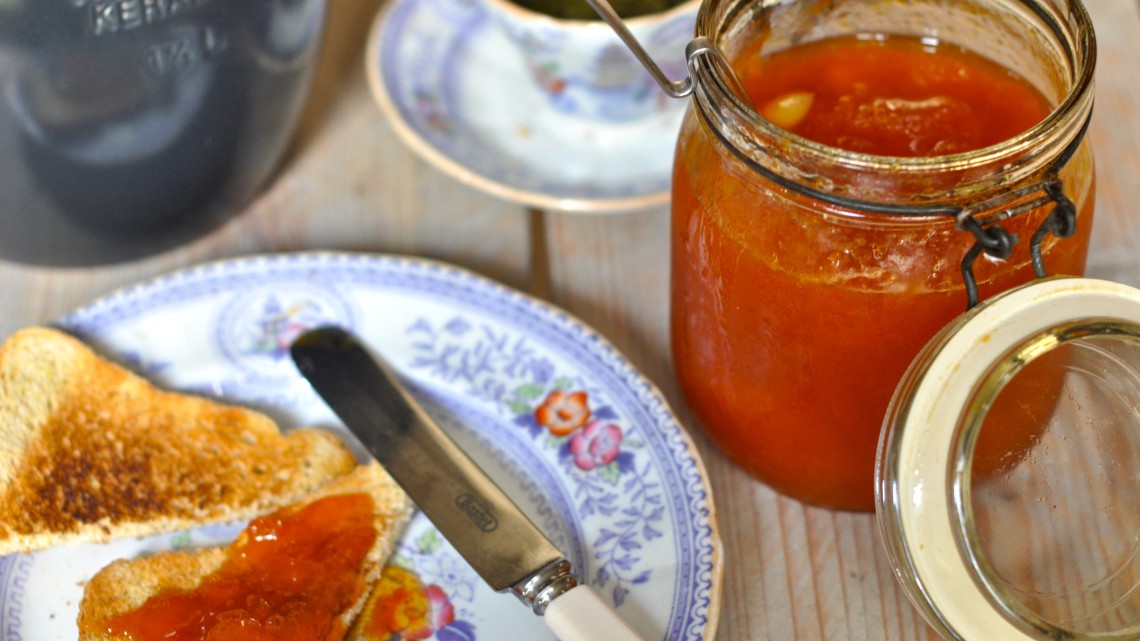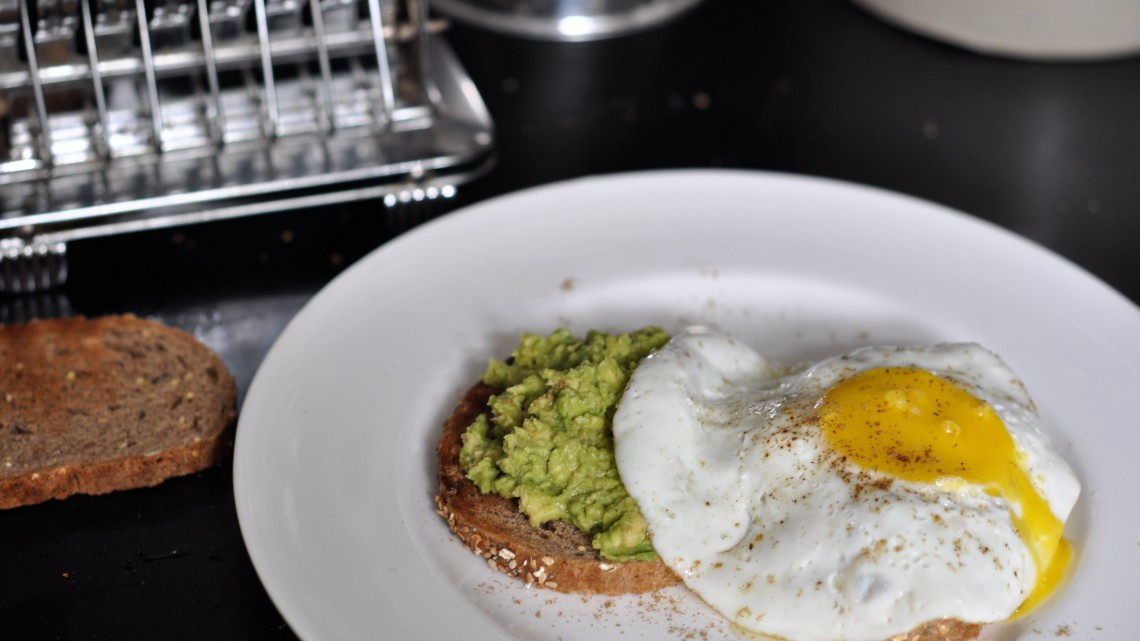Apricot jam
Ingredients
1 kg fresh apricots
800 g sugar
juice of 1 lemon
Method
Rinse the apricots and dry them. Slice in half and remove the stones. Do not throw the stones away. Place the sugar with 250 ml water in a heavy-based pan. Heat the gently and stir until the sugar has dissolved. Bring to the boil until it reached 113° C on a sugar thermometer.
Add the apricots and lemon juice. Bring back to the boil. Skim off any scum which rises to the surface and cook, stirring often for about another 10 minutes. When the bubbles become larger and less in number and the apricots are translucent, check the consistency on a cold saucer or with a sugar thermometer (115° C).
In the meantime, place the apricot stones in a small pan with water and cook them until the skins loosen and that they can easily be removed. Drain off the water and peel off the skins.
Remove the pot from the heat and pour the jam into sterilised jars. Place the peeled stones on top of the jam and close the jars. Allow to cool and store in a cool, dark place. Once opened, be sure to keep in the refrigerator.
We, the Amsterdam Flavours chefs, hope you enjoy this recipe as much as we do. If you have any questions on how to prepare it or just want to send us your feedback, you can reach us here Contact Amsterdam Flavours
Leek and Potato Soup
A classic French soup everyone should have in their repertoire made with simple, humble ingredients. It can be eaten cold too. It's then known as Vichysoisse.
English
Serves 2
Ingredients
40g butter
4 leeks
2 floury potatoes
1 organic vegetable stock cube
1 bay leaf
1 small bunch chives
1 mini baguette
100g grated cheddar
4 tablespoons olive oil
150 ml milk
1,5 tablespoons wholegrain mustard
salt and pepper
Method
Wash the leeks well under cold running water to remove any sand and then thinly slice them. Peel the potatoes and cut into 2 cm cubes. Dissolve the stock cube in 1 liter hot water and preheat the oven to 180° C.
Heat a pot over medium heat with the butter and 4 tablespoons olive oil. Add the sliced leek and potato to the pot and sweat for 2-3 minutes. Add the stock and bay leaf, bring to the boil and cook gently for 10-15 minutes.
Remove the bay leaf from the pot and blend the soup with a stick blender. Add the milk and season the soup with salt and pepper. Keep the soup warm over a low heat. Thinly slice the mini baguette in to diagonal slices. Spread the slices with the mustard, place on an oven tray and sprinkle with the cheddar. Place in the oven for 5 minutes.
Finely chop the chives. Spoon the soup into bowls, sprinkle with the chopped chives and serve with the cheddar toasts.
Nederlands
voor 2 personen
Ingrediënten
40g boter
4 preien
2 kruimige aardappels
1 biologisch groente bouillonblokje
1 laurierblad
1 bosje bieslook
1 pistoletje
100g geraspte cheddar
4 eetlepels olijfolie
150ml melk
1,5 eetlepels grove mosterd
zout en peper
Bereiding
Was de preien goed onder stromend koud water en snijd in dunne plakjes. Schil de aardappels en snijd in blokjes van 2 cm. Los het bouillonblokje op in 1 liter warm water en verwarm de oven voor op 180°C.
Verwarm een pan op medium-vuur met de boter en 4 eetlepels olijfolie. Voeg de gesneden prei en aardappel toe aan de pan en smoor 2 tot 3 minuten. Voeg de bouillon en laurier toe en kook zachtjes voor 10 tot 15 minuten.
Verwijder het laurierblad uit de pan en pureer de soep met een staafmixer. Voeg de melk toe en breng op smaak met zout en peper. Houd de soep warm op een laag vuurtje. Snijd het pistoletje in schuine dunne plakjes, bestrijk met de mosterd, zet ze op een bakplaat bestrooid met de cheddar. Zet in de oven voor 5 minuten.
Snijd de bieslook fijn, lepel de soep in een kom, bestrooi met de bieslook en serveer de toastjes.
Blood Orange Marmalade
This is a recipe we have adapted from Delia Smith.
Makes about 6 x 350 ml jars
Ingredients
900 g blood oranges
1 lemon
1.8 kg granulated sugar
Method
Begin by measuring 2.25 litres water into a preserving pan, then cut the lemon and oranges in half and squeeze the juice out of them. Add the juice to the water and place the pips and any bits of pith that cling to the squeezer on a square of muslin.
Now cut the orange peel into quarters with a sharp knife, and then cut each quarter into thinnish shreds. As you cut, add the shreds to the water and any pips or spare pith you come across should go on to the muslin. The pith contains a lot of pectin so don't discard any and don't worry about any pith and skin that clings to the shreds – it all gets dissolved in the boiling.
Now tie the pips and pith up loosely in the muslin to form a little bag, and tie this on to the handle of the pan so that the bag is suspended in the water. Then bring the liquid up to simmering point and simmer gently, uncovered, for 2 hours or until the peel is completely soft (test a piece carefully by pressing it between your finger and thumb).
Meanwhile, chill a couple of saucers in the freezer.
Next, remove the bag of pips and leave it to cool on a saucer. Then pour the sugar into the pan and stir it now and then over a low heat, until all the crystals have dissolved (check this carefully, it's important). Now increase the heat to very high and squeeze the bag of pips over the pan to extract all of the sticky, jelly-like substance that contains the pectin. As you squeeze you'll see it ooze out. You can do this by placing the bag between two saucers or using your hands. Then stir or whisk it into the rest.
As soon as the mixture reaches a really fast boil, start timing. Then after 15 minutes spoon a little of the marmalade on to one of the cold saucers from the freezer and let it cool back in the fridge. You can tell – when it has cooled – if you have a 'set' by pushing the mixture with your little finger: if it has a really crinkly skin, it is set. If not, continue to boil the marmalade and give it the same test at about 10-minute intervals until it does set.
After that remove the pan from the heat (if there's a lot of scum, most of it can be dispersed by stirring in half a teaspoon of butter, and the rest can be spooned off). Leave the marmalade to settle for 20 minutes.
In the meantime, the jars should be washed, dried and heated in a moderate oven for 5 minutes. Pour the marmalade, with the aid of a funnel or a ladle, into the jars and seal while still hot.
Label when cold and store in a dry, cool, dark place.
We, the Amsterdam Flavours chefs, hope you enjoy this recipe as much as we do. If you have any questions on how to prepare it or just want to send us your feedback, you can reach us here Contact Amsterdam Flavours
Smashed avocado and baked egg
Ingredients
4 slices bread of your choice
2 haas avocados
2 eggs
olive oil
salt and pepper
sprinkling of ground cumin
Method
Halve the avocados, remove the stones and scoop out the flesh. Coarsely mash in a bowl with fork and season with salt and pepper. If you wish, you can add a few drops of lemon juice.
Toast the bread until golden and crispy. Heat a non-stick frying pan with a splash of olive oil. Fry the eggs until cooked to your liking (we prefer sunny side up with a soft yolk). Season with a little salt and pepper.
Spread the mashed avocado on the toast and top with the fried egg. Sprinkle with a touch of ground cumin, before serving.
We, the Amsterdam Flavours chefs, hope you enjoy this recipe as much as we do. If you have any questions on how to prepare it or just want to send us your feedback, you can reach us here Contact Amsterdam Flavours




